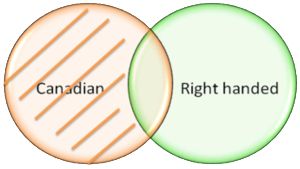
Venn diagrams are today’s mostly used method for solving syllogisms. With some practice they can be drawn fairly quickly making them a valuable tool in solving syllogisms in timed aptitude tests. Venn diagrams show all possible and hypothetically logical relations between a collection of finite and infinite statements. By means of an overlap between some certain assumptions conclusions can be made using the (in)finite statements. Two examples of the use of Venn diagrams will follow to clarify the above.
Example 1:
- All Canadians are right handed
- All right handed are opticians
- Conclusion: Some opticians are Canadian
To check the validity of this statement first the different terms are appointed.
Predicate: Optician
Middle term: Right handed
We will start with the first out of the two given statements from above. The first thing to do is draw two circles and write the terms Canadian
and Right handed
in them. The circle with the word Canadian without the overlap represents only Canadian people, while the part within the overlap with the right handed circle represents all Right handed Canadian people
. Everything outside these two circles represents everything not connected to these two terms. With this one can think of plants, animals, cars but even you and me.































